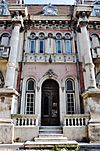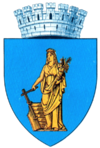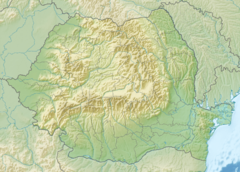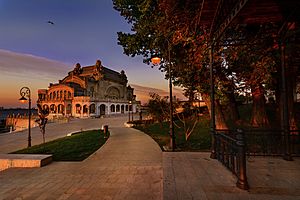Constanța facts for kids
Quick facts for kids
Constanța
|
|||
|---|---|---|---|
|
Top: The Constanța Casino
Second row: the Museum of National History, the Greek Church Third row: The Genoese Lighthouse, the Grand Mosque of Constanța, The house with Lions |
|||
|
|||
| Country | |||
| County | Constanța | ||
| Founded | ca. 6th century BC as Tomis | ||
| Area | |||
| • City | 124.89 km2 (48.22 sq mi) | ||
| • Metro | 1,013.5 km2 (391.3 sq mi) | ||
| Elevation | 25 m (82 ft) | ||
| Population
(2021 census)
|
|||
| • City | 263,688 | ||
| • Density | 2,112/km2 (5,470/sq mi) | ||
| • Metro
(2011)
|
425,916 | ||
| • Ethnic groups | Romanians Tatars Turks Roma Lipovans Aromanians Greeks Armenians | ||
| Demonym(s) | constănțean, constănțeancă (ro) | ||
| Postal code |
900xxx
|
||
| Area code(s) | (+40) 41 | ||
| Vehicle registration | CT | ||
| Languages | Romanian | ||
| Sister cities: Sulmona, Turku, Yokohama, Brest, Istanbul, Rotterdam, Odesa, Boulogne-sur-Mer, Dobrich, Thessaloniki, Mobile, Trapani, Sidon, Lattakia, Heraklion, İzmir, Alexandria, Santos, Havana, Shanghai, Perugia, Novorossiysk. | |||
Constanța is a major port city in the Dobruja region of Romania. It is Romania's fourth largest city and its main port on the Black Sea coast. Constanța is also the capital of Constanța County. It is the oldest city in the region that has been lived in continuously, starting around 600 BC. This makes it one of the oldest cities in Europe.
As of 2021, Constanța has about 263,688 people living there. The Constanța metropolitan area includes 14 nearby towns and villages. This area is one of the largest metropolitan areas in Romania. Over time, many different cultures have shaped Constanța. These include Roman, Byzantine, Bulgarian, and Ottoman influences. After the Russo-Turkish War (1877–1878), Constanța became part of Romania. The city grew a lot during the 20th century.
The Port of Constanța is very large, covering about 39.26 square kilometers. It is the biggest port on the Black Sea and one of the largest in Europe.
Contents
- History of Constanța
- Geography and Climate
- Main Sights and Attractions
- Ovid's Square: A Tribute to a Poet
- Archaeology Park: Glimpses of the Past
- Roman Mosaics: Colorful History
- Genoese Lighthouse: A Beacon of Trade
- Constanța Casino: A Grand Old Building
- House with Lions: Unique Architecture
- Cathedral of Saints Peter and Paul: A Beautiful Church
- Grand Mosque of Constanța: A Place of Worship
- Hünkar Mosque: A Historic Mosque
- Romanian Navy Museum: Exploring Naval History
- Natural Sciences Museum Complex: Animals and Stars
- Economy and Trade
- Transportation Hub
- Sports in Constanța
- Sister Cities
- Education in Constanța
- Images for kids
- See also
History of Constanța
Constanța has a long and interesting history. It was once known as Tomis.
Ancient Times: The City of Tomis
Tomis was founded around 600 BC by ancient Greeks. It was a Greek colony, just like nearby Histria and Kallatis. The city had a great harbor and was protected by high cliffs. This made it a good place for trade and defense.
Most of the old city of Tomis is now covered by modern Constanța. This makes it hard for archaeologists to find ancient ruins. In 29 BC, the Romans took control of the region.
The famous Roman poet Ovid was sent to live in Tomis in 8 AD. He spent the last eight years of his life there. Ovid wrote poems about how much he missed his home. He described Tomis as a faraway place on the edge of the Roman Empire. Many ancient writings and objects found in Constanța prove that it is indeed the site of old Tomis. Some of these items are now in the British Museum in London.
Later, Tomis became the capital of a Roman province called Scythia Minor. In 269 AD, the city was attacked by the Goths. They only managed to destroy areas outside the city walls. Tomis was later renamed Constantiana. This name might have honored Constantia, the half-sister of Emperor Constantine the Great. In 395 AD, Tomis became part of the Eastern Roman Empire.
Middle Ages: Changing Rulers
During the Middle Ages, Tomis was attacked by the Avars. It was then taken over by the First Bulgarian Empire in 680 AD. The Byzantine Empire later took it back. Then, the Second Bulgarian Empire gained control in 1186.
By the 14th century, Italian sailors started calling the city Constanza. After being part of Bulgaria for almost 200 years, Constanța became an independent area. It then fell under the rule of the Ottoman Empire around 1419.
Recent History: Modern Growth
In 1860, a railway was built connecting Constanța to Cernavodă. This helped the city grow. In 1878, after a war, Constanța became part of Romania. It quickly became Romania's main seaport. It was a key place for sending out Romanian goods like grain and oil.
The Constanța Casino is a famous building and a symbol of the city. It was built starting in 1880, right on the Black Sea shore. This beautiful building was once a big attraction for tourists.
During World War I, in 1916, German, Turkish, and Bulgarian troops took over Constanța. The city was later freed by Allied troops in 1918. Between the two World Wars, Constanța became Romania's main trading center. By the 1930s, more than half of Romania's exports went through its port.
During World War II, Constanța was a target for Allied bombers. The city itself was mostly safe, but the port was badly damaged. It took until the early 1950s for the port to fully recover. Recently, the port of Constanța has become very important again. This is because of the conflict in Ukraine, which has made it a key route for shipping grain.
Geography and Climate
Constanța is the main city of its county and the largest city in southeastern Romania. It is located right on the Black Sea coast. The city has a long beach that stretches for 13 kilometers. Mamaia, a part of Constanța, is the biggest and most modern beach resort on the Romanian coast. Many visitors come here in summer for the beaches and mineral springs.
Constanța's Weather
Constanța has a warm, humid climate. Summers are hot and sunny, with average temperatures around 23°C in July and August. A gentle breeze often makes the daytime heat more pleasant. Nights are warm because the sea holds onto the heat.
Autumn starts in mid or late September with warm, sunny days. September can even be warmer than June. The first frost usually happens in mid-November. Winters are milder than in other parts of southern Romania. There isn't a lot of snow, but it can be very windy. December weather is often mild, with high temperatures reaching 8°C to 12°C. The average January temperature is 1°C. Winter storms are common between December and March. Spring arrives early but can be quite cool.
Main Sights and Attractions
Constanța has many interesting places to visit that show its rich history and culture.

Ovid's Square: A Tribute to a Poet
This square in the old town is named after the Roman poet Ovid. He was exiled to Tomis (now Constanța) in 8 AD. In 1887, a statue of Ovid was placed here. There is an exact copy of this statue in Sulmona, Ovid's hometown in Italy. The statue stands in front of the Constanța History and Archaeology Museum. This museum has a large collection of ancient art.
Archaeology Park: Glimpses of the Past
In the middle of Constanța, this park shows many old remains of the city. You can see columns, ancient jars called amphorae, and parts of buildings from the 3rd and 4th centuries. There is also a 6th-century tower.
Roman Mosaics: Colorful History
In Ovid's Square, you can see parts of a huge Roman building complex. It once connected the upper town to the harbor. Today, about a third of the original buildings remain. They include over 9150 square feet of colorful mosaics. You can also see remains of Roman public baths nearby.
Genoese Lighthouse: A Beacon of Trade
This lighthouse, standing 26 feet tall, was built in 1860. It honors the Genoese merchants who created a busy sea trade community here in the 13th century.
Constanța Casino: A Grand Old Building
The Constanța Casino was built in 1910. It has a beautiful Art Nouveau style and is located right on the seashore. It was once a popular spot for European tourists. The building is currently being renovated. The Constanța Aquarium is also nearby.
House with Lions: Unique Architecture
This building from the late 19th century mixes different architectural styles. It has four columns decorated with impressive lion sculptures.
Cathedral of Saints Peter and Paul: A Beautiful Church
This church was built between 1883 and 1885 in a neo-Byzantine style. It was damaged during World War II but was restored in 1951. The inside of the church has murals that combine Byzantine and Romanian art.
Grand Mosque of Constanța: A Place of Worship
Built in 1910, the Grand Mosque of Constanța is an important place for the Muslim community. It combines Neo-Byzantine and Romanian architectural styles. Inside, there is a huge Turkish carpet, a gift from Sultan Abdülhamid II. It is one of the largest carpets in Europe. The mosque's tall minaret (tower) is 164 feet high. You can climb its 140 steps for great views of the old town and harbor.
Hünkar Mosque: A Historic Mosque
The Hünkar Mosque was finished in 1869. It was built for Turks who moved to Constanța after the Crimean War. It is still used by the Muslim community today.
This museum is the largest of its kind in Romania. It shows the history of the country's military and civilian navy. You can see models of ships, different types of knots, anchors, and navy uniforms.
Natural Sciences Museum Complex: Animals and Stars
This complex is like a zoo. It has a dolphinarium, an exhibition of exotic birds, and a micro-Delta. There is also a planetarium next door.
Economy and Trade
Constanța is a major center for industry, trade, and tourism in Romania. The Port of Constanța is the largest on the Black Sea and the fourth largest in Europe. The city also has a large shipyard.
Tourism has become more and more important in recent years. Constanța has been a seaside resort since the time of King Carol I. The city's beaches were greatly improved in 2020 with new sand. Constanța gets many visitors each year who explore its sights and enjoy the Neversea festival. The city is also a center for business and education, which helps the local economy.
Transportation Hub
Constanța is a key transport center.
Road and Rail Connections
A railway line opened in 1895 connects Constanța to Bucharest. This line crosses the Danube River over a large bridge. This railway helped Constanța become a major place for trading goods. The A2 motorway also connects Constanța quickly to Bucharest. The A4 motorway helps direct heavy traffic around the city and to the port.
Port of Constanța: A Gateway to the Sea
The Port of Constanța is very important. It is protected by long walls called breakwaters and has a lighthouse. A large canal, the Danube-Black Sea Canal, connects the Danube River directly to the Black Sea at Constanța. This makes it easier to transport goods. The Romanian navy also has its Black Sea fleet stationed here.
Air Travel
The city is served by Mihail Kogălniceanu International Airport.
Public Transport
Constanța has a public transport system run by CT Bus. It includes 19 bus lines that run all year. There are also two seasonal lines, including a double-decker sightseeing bus. In 2014, all public buses got free Wi-Fi. You can also buy tickets by sending a text message. In 2022, new electric buses started running in Constanța.
Constanța is also a main focus of the Rail-2-Sea project. This project aims to build a long railway line connecting Constanța to the Polish port of Gdańsk on the Baltic Sea.
Sports in Constanța
Constanța is home to several sports teams. The city has football clubs, including FCV Farul Constanța, which plays in Romania's top league. There are also rugby and handball teams. Many Olympic champion gymnasts and famous athletes were born in Constanța. These include Camelia Voinea, Nicoleta Daniela Sofronie, Simona Amânar, Cătălina Ponor, and swimmer Răzvan Florea. Tennis star Simona Halep is also from Constanța.
Constanța and Mamaia also host the European Triathlon Union (ETU) Triathlon European Cup.
Sister Cities
Constanța is twinned with many cities around the world. This means they have special friendly relationships and often work together on projects. Some of its sister cities include:
- Alexandria, Egypt
- Brest, France
- Fort Lauderdale, United States
- Havana, Cuba
- Istanbul, Turkey
- Mobile, United States
- Odesa, Ukraine
- Rotterdam, Netherlands
- Saint Petersburg, Russia
- Shanghai, China
- Sulmona, Italy
- Thessaloniki, Greece
- Turku, Finland
- Yokohama, Japan
Education in Constanța
Constanța has many schools and universities.
High Schools
- Carol I Economic College
- Mircea cel Bătrân National College
- Constantin Bratescu National College
- Pontica Technical College of Constanta
- Mihai Eminescu National College
- Lucian Blaga High School
- Electrotechnics and Telecommunication High School
- George Călinescu High School
- Ovidius High School
- Decebal High School (Constanța)
- Traian High School (Constanța)
- International Computer Science High School of Constanța
- "Nicolae Rotaru" Sports High School
- Orthodox Theological Seminary
- National College of Arts "Queen Marie"
- Tomis Technical College
Universities
- Mircea cel Bătrân Naval Academy
- Constanța Maritime University
- Ovidius University
- Andrei Șaguna University
- Tomis University
- Dimitrie Cantemir University
International Schools
- Cambridge School of Constanța (CSC)
Images for kids
See also
 In Spanish: Constanza (Rumania) para niños
In Spanish: Constanza (Rumania) para niños



























